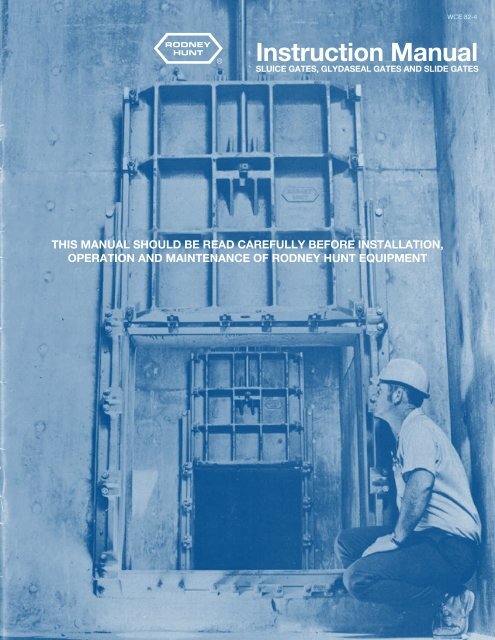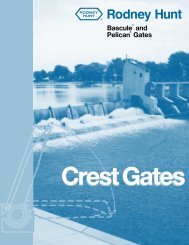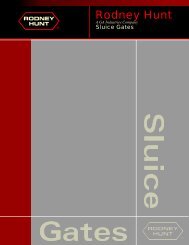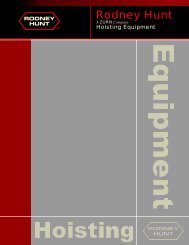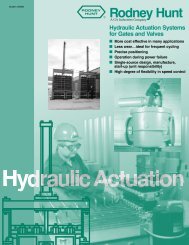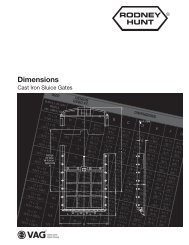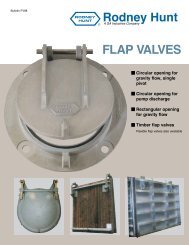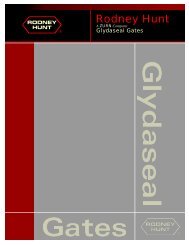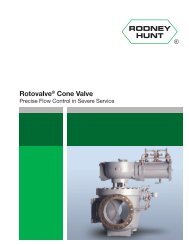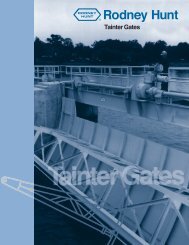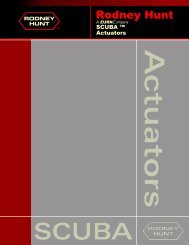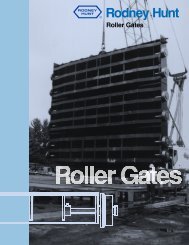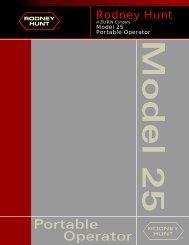Instruction Manual - Rodney Hunt Company
Instruction Manual - Rodney Hunt Company
Instruction Manual - Rodney Hunt Company
Create successful ePaper yourself
Turn your PDF publications into a flip-book with our unique Google optimized e-Paper software.
THIS MANUAL SHOULD BE READ CAREFULLY BEFORE INSTALLATION,<br />
OPERATION AND MAINTENANCE OF RODNEY HUNT EQUIPMENT<br />
WCE 82-4<br />
<strong>Instruction</strong> <strong>Manual</strong><br />
SLUICE GATES, GLYDASEAL GATES AND SLIDE GATES
TABLE OF CONTENTS<br />
Page<br />
Introduction ..................................................................3<br />
Handling and Storage ..................................................4<br />
Sluice Gate Installation .................................................6<br />
Hy-Q Sluice Gate .......................................................10<br />
Conventional Sluice Gate ...........................................11<br />
Field Adjustment ........................................................12<br />
Glydaseal Gates .........................................................14<br />
Slide Gate Installation ................................................18<br />
Operating Mechanisms ..............................................19<br />
Pipe Covers, Indicators ..............................................21<br />
Stems and Stem Guides ............................................22<br />
Operating Sluice Gates ..............................................23<br />
Operating Slide Gates ................................................24<br />
Trouble Shooting Tips, Sluice Gates ..........................25<br />
Trouble Shooting Tips, Slide Gates ............................28<br />
Maintenance ...............................................................29<br />
General Notes ............................................................30<br />
Field Service Policy .....................................Back Cover<br />
Copyright 1979<br />
<strong>Rodney</strong> <strong>Hunt</strong> <strong>Company</strong><br />
Orange, Massachusetts<br />
The information herein is, to our knowledge, true and accurate However, <strong>Rodney</strong> <strong>Hunt</strong><br />
<strong>Company</strong> makes no warranties or representation, expressed or implied, other than those<br />
set forth in the specifications or a formal quotation. No agent, representative or employee<br />
of this company is authorized to vary the terms of this notice
Introduction<br />
This manual describes the recommended methods of<br />
installation, adjustment, initial operations, maintenance<br />
and safety precautions for <strong>Rodney</strong> <strong>Hunt</strong> sluice gates,<br />
slide gates, operating mechanisms and related equipment.<br />
It should be used in conjunction with approved<br />
drawings provided by the <strong>Rodney</strong> <strong>Hunt</strong> <strong>Company</strong>.<br />
The information in this manual pertains to most <strong>Rodney</strong><br />
<strong>Hunt</strong> gates. However, there are special installations<br />
which require more specific information. In these cases<br />
a special set of instructions is forwarded to the gate user<br />
before installation.<br />
<strong>Rodney</strong> <strong>Hunt</strong> sluice gates have been designed and manufactured<br />
to result in a nearly watertight closure. Before<br />
leaving the <strong>Rodney</strong> <strong>Hunt</strong> plant, equipment is inspected<br />
and the gate wedges are properly adjusted.<br />
This installation drawing is typical of many sent to the contractor long<br />
before sluice gates are cast.<br />
These precautions result in gates with low leakage characteristics.<br />
However, great care must be used in the<br />
handling, storage and installation of <strong>Rodney</strong> <strong>Hunt</strong> sluice<br />
gates to insure that they will operate as designed, and<br />
with maximum watertightness.<br />
<strong>Rodney</strong> <strong>Hunt</strong> slide gates have also been designed and<br />
manufactured to meet your specific requirements.<br />
The information in this manual is intended only as a recommendation<br />
for the proper and satisfactory installation<br />
of our equipment. <strong>Rodney</strong> <strong>Hunt</strong> <strong>Company</strong> assumes<br />
no liability, expressed or implied, for the interpretation<br />
of the recommendations or the faulty installation of the<br />
gates. Its responsibility is limited to defects in manufacturing<br />
rather than installation, adjustment and related<br />
problems subsequent to manufacturing.<br />
Special instruction manuals for intricate systems and components<br />
are also prepared for the contractor.<br />
3
Handling and Storage<br />
For Safety<br />
To prevent personal injury or equipment damage,<br />
follow standard safety procedures when handling<br />
equipment and be sure rigging equipment is properly<br />
placed and in safe working condition.<br />
Although <strong>Rodney</strong> <strong>Hunt</strong> sluice gate equipment is durable<br />
and heavily constructed, there are precision-machined<br />
seat and wedge facings which require a great deal<br />
of attention and care when being installed. Stem<br />
threads and hoists have precision surfaces that should<br />
be protected from damage.<br />
Sluice gates are provided with locking plates to hold the<br />
disc firmly in place in the guides during shipping and<br />
installation. Gates can be lifted by a chain or sling<br />
Locking plates are positioned above the disc or between the disc<br />
and guide on either side of the frame.<br />
4<br />
through the stem hole in the disc only when locking<br />
plates are in place. Locking plates have been designed<br />
to withstand normal lifting stresses. When lifting<br />
gates, take special care to protect machined surfaces<br />
and wedges. Locking plates must be removed before<br />
opening gate.<br />
Equipment should be stored on planks or timbers over<br />
an even surface to keep them off the ground and to<br />
prevent distortion. Equipment should also be covered<br />
Sluice gate is properly lifted by the stem hole in the disc as long as<br />
locking plates are in place.
to protect seat facings and other machined surfaces<br />
from foreign matter. Where there are a number of medium<br />
or small gates and where storage space is limited,<br />
it may be necessary to stack the gates. Sluice gates<br />
should not be stacked more than three high, and then,<br />
only with heavy timber blocking placed between the<br />
gates to prevent damage to gates.<br />
To prevent bending when lifting, handling and storing,<br />
stems should be supported over their full length. They<br />
Note how stem is<br />
carefully supported<br />
when lifted.<br />
Gates and Hoists stored at the construction site awaiting installation.<br />
should be stored carefully only on an even surface in<br />
a clean, dry area. The threaded portion of the stem is<br />
protected by a heavy fiber cover which should not be<br />
removed until the stem is ready for installation. Couplings<br />
and thrust nuts are shipped in place on the stems<br />
and should be removed prior to installation. Stop collars<br />
are normally shipped in a bag or box accompanying the<br />
floor stands. Operating mechanisms should be handled<br />
and treated as precision machinery and protected accordingly.<br />
Refer to page 29.<br />
Stems are supported evenly<br />
and kept off the ground.<br />
5
Installation Items Embedded in Concrete<br />
The most important single aspect of a sluice gate installation<br />
is the correct placement of the embedded<br />
items in the concrete. If these embedded items are accurately<br />
and carefully located and held in place during<br />
the concrete pour, a proper sluice gate installation is<br />
practically assured.<br />
A careful embedment of wall thimbles in concrete is an essential<br />
first step in a proper gate installation.<br />
6<br />
WALL THIMBLES<br />
1. The front face of all <strong>Rodney</strong> <strong>Hunt</strong> thimbles . . . .rectangular,<br />
square and circular . . . . are marked on vertical<br />
and horizontal centerlines. The centerline marks are also<br />
placed on the outer edge of the mounting flange of the<br />
wall thimble so that they can be seen after the thimbles<br />
are bolted to the forms.<br />
2. Wall thimbles should be set with the top mark up and<br />
top and bottom centerline marks plumb.<br />
3. After being set at the proper elevation, the wall thimble<br />
must be internally braced to carry the weight of<br />
the concrete. Care should be used in placement of the<br />
braces so as not to distort the wall thimble. Gate attaching<br />
holes and hardware will be misaligned if the wall<br />
thimble is distorted.<br />
4. The wall thimble should be firmly supported on the<br />
form. The studs and nuts furnished with the thimble can<br />
be used for bolting the thimble in place. Forms should<br />
be supported and stiffened against movement. If forms<br />
move they will distort the wall thimble mounting flange,<br />
and the sluice gate will leak.<br />
Every <strong>Rodney</strong> <strong>Hunt</strong> wall thimble is shipped with a centerline scribe<br />
on its front face and top edge before leaving the factory. The top of<br />
the thimble is clearly marked. In this way, thimbles can be mounted<br />
and aligned quickly into position during installation.
5. The tapped holes in the face of the wall thimble must<br />
be plugged or capped to prevent concrete from entering<br />
the holes. <strong>Rodney</strong> <strong>Hunt</strong> furnishes wall thimbles with<br />
plastic caps in the ends of each tapped hole. These caps<br />
should be left in place until the thimble is cast in the concrete<br />
and the gate is prepared for installation. The caps<br />
are easily removed by puncturing with a screw driver.<br />
6. Where the depth of the wall thimble and thickness<br />
of the wall are the same, care is taken to maintain the<br />
length of the thimble within acceptable tolerances. This<br />
prevents distortion of the forms or the necessity of<br />
blocking the area between the casting and the forms.<br />
7. After the concrete has hardened and the forms removed,<br />
the front surface of the wall thimble should be<br />
thoroughly cleaned. Make sure to remove any concrete<br />
that has flowed onto the surface from the edges. Care<br />
should be taken to prevent damage to machined surfaces.<br />
The front flange of each <strong>Rodney</strong> <strong>Hunt</strong> wall thimble<br />
is purposely oversized to minimize this problem.<br />
ANCHOR BOLTS<br />
Anchor bolts may be furnished for mounting gates, supporting<br />
the upper gate guides, or mounting stem guides<br />
and hoists. The location and projection of the anchor<br />
bolts are shown on the installation drawing. Anchor bolts<br />
should be placed in the holes drilled in the forms at locations<br />
indicated on the drawings. The hook ends of the<br />
anchor bolts should then be wired to the opposite form<br />
or to reinforcing rods to hold the bolts firmly in place.<br />
Typical anchor bolt configuration.<br />
<strong>Rodney</strong> <strong>Hunt</strong> wall thimbles are furnished with plastic cap plugs in the<br />
mounting holes to prevent damage to threads and to keep concrete<br />
out of the holes.<br />
7
Sluice Gates<br />
A sluice gate should be set on wall thimble studs or anchor<br />
bolts as a complete un it. It is essential that the gate<br />
disc be firmly wedged in the closed position so that the<br />
unit will be held rigid to prevent distortion. The sluice<br />
gate can be lifted by the stem hole in the disc only when<br />
the locking plates are in place. In this way, the gate will<br />
hang nearly vertical.<br />
Gates, properly stacked, await installation on a construction site.<br />
Sluice gates leaving <strong>Rodney</strong> <strong>Hunt</strong> are well secured and protected<br />
against in-transit damage.<br />
8<br />
INSTALLATION ON WALL THIMBLES<br />
1. The face of the wall thimble should be thoroughly<br />
cleaned and all wall thimble studs in place. Care should<br />
be taken to prevent damage to machined surfaces. The<br />
plastic plugs in the bolt holes are easily removed by<br />
puncturing with a screwdriver.<br />
2. A gasket should be provided between the surface of<br />
the wall thimble and the mounting flange of the sluice<br />
gate. A butyl rubber mastic is normally supplied with<br />
<strong>Rodney</strong> <strong>Hunt</strong> gates for this purpose and should be applied<br />
in accordance with the label directions.<br />
3. If gasket material other than mastic is used, it should<br />
be installed over the studs to provide a smooth mounting<br />
surface for the gate. If the gasket is other than one<br />
piece, the dovetailed gasket joints should be aligned<br />
in accordance with the match markings and cemented<br />
with a liquid-type gasket material. When applying gasket<br />
materials, care should be taken to ensure that excessive<br />
amounts of lumpy, dried materials are not present when<br />
the sluice gate is drawn tightly to the wall thimbles.<br />
4. The mounting flange of the sluice gate should be thoroughly<br />
cleaned. Care should be taken to prevent damage<br />
to machined surfaces.<br />
5. The gate can then be lifted and set over the studs,<br />
and nuts put in place and tightened. The sequence of<br />
tightening should be as indicated in the drawings below.<br />
Nearly equal torque should be applied to all nuts so that<br />
the gate is firmly and evenly tightened to the mounting<br />
flange without distortion.<br />
RECTANGULAR OR<br />
SQUARE OPENING<br />
SLUICE GATE<br />
CIRCULAR OPENING<br />
SLUICE GATE<br />
INSTALLATION WITH ANCHOR BOLTS<br />
Where sluice gates are mounted on anchor bolts it is<br />
recommended that 1” of grout be placed between the<br />
mounting flange of the gate and the concrete wall. The<br />
projection of the anchor bolts shown on the installation<br />
drawings includes provisions for this 1” of grout.
1. All anchor bolt threading should be checked to make<br />
sure that threads are undamaged.<br />
2. The gate should be lifted and put in place over the<br />
anchor bolts. Attach nuts.<br />
3. Shims should be placed between the back flange of<br />
the sluice gate and the concrete wall in sufficient number<br />
so that the gate will be plumb and flat and can be<br />
firmly tightened against the shims without distortion.<br />
4. With the gate flange located approximately 1” from<br />
the wall, a non-shrink grout should be placed between<br />
the flange and the concrete wall.<br />
5. After the grout has hardened, the shims can be removed<br />
and the nuts further tightened so that the gate is<br />
firmly in place against the grout.<br />
UPPER GATE ANCHOR BOLTS<br />
1. Embedded anchor bolts required to support the upper<br />
gate guides must be positioned in forms at the time the<br />
concrete is poured.<br />
2. These anchor bolts are provided with double nuts so<br />
that upper gate guides can be firmly clamped in position.<br />
The back-up nuts must be placed on the anchor<br />
bolts before the gate is installed.<br />
The gate should not be bolted directly to an uneven<br />
surface. Even a very small amount of gate distortion<br />
will cause excessive leakage.<br />
INSTALLATION ON PIPE FLANGES<br />
1. Where sluice gates are mounted on cast-iron pipe<br />
flanges, the procedure is the same as when the gate is<br />
mounted on a wall thimble.<br />
2. Where the gate is being mounted on a steel flange<br />
that has been welded to a pipe or adaptor, the front surface<br />
of the pipe or adaptor will not be sufficiently flat<br />
unless it has been machined after welding.<br />
A. The gate should be bolted loosely to the flange so that<br />
surfaces touch. Be sure that neither surface is distorted.<br />
A feeler gauge should be used to check the clearance<br />
completely around the periphery of the gate.<br />
B. Leakage may occur if the distortion is more than<br />
0.010 when the two surfaces are bolted together.<br />
C. By using a thick fibrated mastic between surfaces,<br />
it may be possible to prevent leakage between flanges.<br />
In no case should the gate flange be firmly tightened<br />
against a flange that is not flat.<br />
D. If the spacing is very large, the gate should be<br />
shimmed a small distance away from the flange. Space<br />
between the flanges can be caulked with non-shrink<br />
epoxy grout. This will allow the gate to be tightened to<br />
the steel flange without distortion or leakage between<br />
the flanges.<br />
Consult the factory for assistance if the flange on which<br />
the gate is to be installed is not flat and the gap between<br />
the gate flange and the mounting flange is excessive.<br />
NUT TIGHTENING TORQUE<br />
Proper tightening of nuts on anchor bolts or studs holding<br />
the sluice or slide gate to the wall or wall thimble may<br />
prevent serious problems in operation or performance<br />
of the gate. Tabulated below are recommended torque<br />
values for common fastener sizes.<br />
*DIAMETER (in.) TORQUE (ft.-lb.)<br />
1/2 35<br />
5/8 75<br />
3/4 100<br />
7/8 150<br />
1 200<br />
*Consult with factory for sizes not shown.<br />
HY-Q ® SLUICE GATE<br />
Hy-Q flush-bottom sluice gates are installed in the same<br />
manner as conventional gates. However, after the gate<br />
has been installed it is necessary to fill the cut-out, or<br />
recess, which has been left beneath the gate. It can be<br />
filled with asphalt surfacing material which packs firmly,<br />
or concrete which contains sawdust or vermiculite. The<br />
recess should be filled level with the floor of the chamber<br />
and with the top of the cast-iron stop bar on the sluice<br />
gate.<br />
The stop bar must be thoroughly cleaned after installation<br />
and prior to use.<br />
The flush-bottom closure gate must not be supported<br />
in the open position by blocks placed beneath the<br />
resilient seal, since damage to the seal may occur.<br />
Recessed area beneath HY-Q ® gate can be filled with surfacing material<br />
or concrete.<br />
9
10<br />
HY-Q ® Sluice Gate<br />
The Hy-Q sluice gate is different than conventional gates<br />
in that it uses a heavy resilient strip on the bottom of the<br />
disc rather than wedges. It is generally used to eliminate<br />
the need for vertical walls or pockets on the invert surface<br />
which might otherwise impede flow. It makes an<br />
extremely effective invert seal when compressed against<br />
the stop bar attached to the gate frame. A typical installation<br />
of a Hy-Q sluice gate with flush bottom closure is<br />
shown in the diagram at left. Care should be taken to<br />
ensure that the resilient seal is not damaged by blocks<br />
which might be used to keep the gate open or by concrete<br />
or debris on the stop bar.<br />
FIELD ADJUSTMENT —HY-Q<br />
Setting wedges on Hy-Q sluice gates requires a slightly<br />
different procedure than conventional gates.<br />
First loosen all wedges so there is no contact between<br />
the wedges and wedge seats. Using the operating<br />
mechanism, the gate disc should be lowered to compress<br />
the resilient seal to the degree required for proper<br />
sealing. After the resilient seal is compressed, wedges<br />
should be adjusted as described on pages 12 and 13.<br />
The wedges on Hy-Q gates can be over-tightened, and<br />
this should be avoided. Setting the wedges too tightly<br />
will tend to raise the gate disc and allow leakage beneath<br />
the seal. When properly set, there should be less<br />
than 0.004 inches clearance between the seat facings at<br />
the top and sides. The bottom seal should firmly clamp a<br />
sheet of paper in place against the stop bar at any point<br />
along the invert.<br />
® SLUICE GATES<br />
When properly set, this bottom HY-Q seal should firmly clamp a<br />
sheet of paper in place against a stop bar at any point along the<br />
invert.
Conventional Sluice Gates<br />
These illustrations show how a conventional <strong>Rodney</strong><br />
<strong>Hunt</strong> sluice gate is assembled and disassembled with<br />
parts keyed to a legend for identification. Conventional<br />
<strong>Rodney</strong> <strong>Hunt</strong> sluice gates are essentially the same design<br />
as the Hy-Q gate, but without the resilient seal and<br />
stop bar. Both types of gates are available as self-contained<br />
units with yokes. Large and special gates are<br />
often shipped partially disassembled. Match markings<br />
should be carefully noted when gate and components<br />
are assembled.<br />
These self-contained gates are supplied with rising stems so the<br />
stem threads can be kept out of water. They are operated by a bench<br />
stand mounted on a yoke. Unlike conventional gates, the guides of<br />
self-contained gates are longer to fully support the yoke and the disc<br />
in the open position.<br />
LEGEND<br />
A Frame<br />
B Gate Disc<br />
C Gate Guide<br />
D Top Wedge<br />
E Bottom Wedge<br />
F Side Wedge<br />
G Nut Pocket<br />
H Seat Facing<br />
11
Field Adjustment<br />
It is not unusual to have to make minor wedge adjustments<br />
on sluice gates after installation. Electric operator<br />
“open” and “close” limit switches must always be set<br />
after installation. These adjustments are the responsibility<br />
of the installing contractor unless specifically included<br />
in the purchase order.<br />
SLUICE GATES<br />
Before a sluice gate is shipped from the factory the adjustable<br />
wedges are properly set. However, vibration<br />
in the handling and shipping of the gate can loosen or<br />
change the setting of the wedges and resetting may be<br />
required after installation. The procedure for correctly<br />
setting the side, top and bottom wedges is as follows:<br />
12<br />
SIDE WEDGES<br />
1. Loosen nuts clamping all wedges in place (E).<br />
2. Loosen lock nuts (C) on bronze adjusting screws (B)<br />
and back screws out several turns.<br />
3. Close gate so that horizontal seat facing on disc is<br />
aligned with horizontal seat facing (D) on frame.<br />
4. Tap wedges (A) downward into position with light<br />
hammer blows until all wedges are evenly tightened.<br />
5. Tighten adjusting screws (B) to bear against studs.<br />
6. Tighten adjusting screw lock nuts (C).<br />
7. Tighten nuts (E).<br />
CAUTION!<br />
When working around the sluice gate in the open position,<br />
care should be taken to ensure that the disc is<br />
securely supported.
TOP WEDGES<br />
1. Loosen nuts (E) clamping wedges in place sufficiently<br />
to allow wedges to slide.<br />
2. Back adjusting screw lock nuts (C) away from wedges.<br />
3. Tighten adjusting screws (B) until desired wedge<br />
tightness is reached.<br />
4. Simultaneously tap wedges (A) with hammer directly<br />
over the wedge seats to assure that wedges do not deflect.<br />
5. Tighten nuts (E) clamping wedges in place.<br />
6. Tighten adjusting screw lock nuts (C) against wedges.<br />
Note: Ensure that the gate wedge is flat against the<br />
machined boss on the gate disc and square to the<br />
wedge loop during and after adjustment.<br />
BOTTOM WEDGES<br />
1. Loosen nuts (E) clamping wedges in place sufficiently<br />
to allow wedges to slide.<br />
2. Back adjusting screw lock nuts (C) away from wedges.<br />
3. Turn adjusting screws (B) until desired wedge tightness<br />
is reached.<br />
4. Tighten nuts (E) clamping wedges in place.<br />
5. Tighten adjusting screw lock nuts (C) against wedges.<br />
Note All Wedges and Adjustments: When the wedges<br />
are properly set, the clearance between the seat facings<br />
on the disc and frame should not exceed 0.004<br />
inches. Each wedge should be tightened to the same<br />
degree. When tightening adjusting screws, do not<br />
use a wrench larger than 8 inches in length.<br />
13
Glydaseal Gates<br />
The <strong>Rodney</strong> <strong>Hunt</strong> Glydaseal sluice gate is a well designed,<br />
heavily constructed gate suitable for many<br />
years of excellent performance with very little leakage.<br />
However, it has precisely machined surfaces and well<br />
matched seat facings that are essential for its low leakage<br />
performance The care with which this equipment is<br />
handled, stored and installed has an important bearing<br />
on how well the gate will perform in service.<br />
14<br />
The instructions for the proper handling, storage and<br />
installation of the Glydaseal gate are the same as for<br />
a conventional sluice gate. These are described in this<br />
<strong>Rodney</strong> <strong>Hunt</strong> <strong>Instruction</strong> <strong>Manual</strong>.<br />
Adjustment of the Glydaseal gate differs from standard<br />
sluice gates, and these instructions should be followed<br />
closely if adjustments are required.<br />
48” x 60” self-contained Glydaseal sluice gates controlling effluent<br />
from chlorine contact tank.
NUT<br />
POCKET<br />
GUIDE<br />
BRONZE<br />
GUIDE BAR<br />
RESILIENT<br />
INVERT<br />
SEAT<br />
DISC<br />
SEAT<br />
FACING<br />
LOCKING<br />
BOLT<br />
FRAME<br />
GUIDE BAR<br />
ATTACHING BOLT<br />
15
Glydaseal Gate Installation<br />
This <strong>Instruction</strong> <strong>Manual</strong> describes the installation of conventional<br />
sluice gates. All of the same directions should<br />
be followed for installation of the Glydaseal gate. However,<br />
there are four instructions that should be followed<br />
closely for the successful performance of the Glydaseal<br />
sluice gate.<br />
1. The locking plates that hold the disc to the frame and<br />
prevent it from opening must be removed prior to opening<br />
the gate. These are located at the top edge of the<br />
disc.<br />
16<br />
2. Concrete or foreign matter must be removed from<br />
the top of the gates, from the PVC seat facings on the<br />
frame and the seal on the disc. These surfaces must be<br />
clean to ensure that they are not damaged during initial<br />
operation.<br />
3. The guide bar studs (C) should not project beyond<br />
the guide bar.<br />
4. If the Glydaseal is to be field painted, the seal, the PVC<br />
seat facing, the bronze bar and the guide bar groove in<br />
the disc should be well masked to exclude paint from<br />
those surfaces.<br />
LEGEND<br />
A Hex Head Cap Screw<br />
B Hex Nut<br />
C Guide Bar Stud<br />
D PVC Facing<br />
E Disc Seal<br />
F Frame<br />
G Disc<br />
H Guide Bar<br />
I Flush Bottom Seal<br />
J Stem<br />
K Thrust Nut
Glydaseal Gate Adjustment<br />
All <strong>Rodney</strong> <strong>Hunt</strong> Glydaseal gates are carefully checked<br />
and adjusted at the factory prior to shipment to assure<br />
that they meet the specified leakage requirements. Further<br />
adjustment in the field will normally not be required,<br />
and no adjustment should be undertaken unless there is<br />
clear evidence that the seal attached to the disc is not<br />
contacting the PVC facing attached to the frame when<br />
the gate is fully closed. This can be determined by trying<br />
to place a feeler gauge between the disc seal and PVC<br />
seat facings (D and E) with the gate in the fully closed<br />
position.<br />
Any adjustment should be made when the water level is<br />
below the invert of the gate.<br />
If adjustment is necessary, the following procedures<br />
should be followed:<br />
1. Raise the gate disc (G) 1” to 1-1/2” above the flush<br />
bottom seal (I).<br />
2. Loosen the guide bar hex-head locking screw (A) on<br />
each side of the gate.<br />
3. Loosen the hex-nut (B) on each side of the frame.<br />
4. Re-tighten the hex-head screws (A) against the<br />
guide bar studs until the disc seal (E) is in contact with<br />
the PVC seat (D). The adjustment of each screw should<br />
be made a small amount at each time and alternate between<br />
the sides of the gate to distribute the load evenly.<br />
5. With a feeler gauge determine that the disc seal is<br />
in touch with the PVC seat across the top and along<br />
both sides of the gate.<br />
6. Once the adjustment has been made, re-tighten all<br />
hex-nuts (B) along each side of the gate.<br />
The Glydaseal is now ready for use. When the disc is<br />
fully closed the disc seal will be compressed the proper<br />
amount for low leakage performance.<br />
No other adjustments are required on the Glydaseal<br />
gate.<br />
Adjusting the bronze guide bar varies the seal compression.<br />
17
Slide Gates<br />
INSTALLATION<br />
The most important aspects of a slide gate installation<br />
are listed below. If these are accurately followed,a<br />
proper slide gate installation, is assured. To minimize<br />
leakage the seating surfaces of the slide gate frame<br />
must be installed flat.<br />
The following sketches are for “Box-Out” dimensions<br />
that are recommended for standard aluminum slide gate<br />
applications.<br />
WALL MOUNTED SLIDE GATES<br />
The frame must be flat and square, and properly anchored<br />
in accordance with the installation drawings prior<br />
to grouting to avoid distortion.<br />
EMBEDDED SLIDE GATES<br />
The frame must be well supported to prevent distortion<br />
that will cause binding of the slide and leakage.<br />
PLATE ABOVE OPENING<br />
When a top seal plate is furnished across the top of the<br />
opening, it must be installed flat to prevent leakage.<br />
BEFORE OPERATING SLIDE GATES<br />
1. Clean the gate slide, guides, invert and stem of all<br />
sand, concrete droppings, paint and other debris.<br />
2. Check to make sure that stem guides and brackets<br />
are securely fastened.<br />
3. Clean and lubricate the stem threads.<br />
NOTE: For information regarding: stem guides, hoisting equipment and field service, see sections in booklet under their respective titles.<br />
18<br />
EMBEDDED SLIDE GATE<br />
(Side Guide)<br />
SPIGOT GATE WITH J-SEAL<br />
(Side Guide)<br />
GATE SILL<br />
FLUSH INVERT
Operating Mechanisms<br />
MANUALLY OPERATED FLOOR STANDS<br />
All floor stands and operating devices are identified by a<br />
tag showing the installation drawing number and should<br />
be used with the proper gate and stem.<br />
1. After the stem has been completely assembled and<br />
positioned in place, the manual operator can be lowered<br />
onto the stem and turned into position by operation of<br />
the handwheel or crank.<br />
2. Shims should be placed between the floor and the<br />
operator so that the operator is plumb and the base of<br />
the floor stand is approximately 1” above the operating<br />
floor. (Illustration below)<br />
LEGEND<br />
A. Bronze Operating Nut<br />
B. Lubrication Fittings<br />
C. Bevel Gears<br />
D. Cut Spur Gears<br />
E. Needle Bearing and Oil Seal<br />
3. Approximately 1” of grout should then be placed between<br />
the pedestal base and the operating floor.<br />
4. After the grout has hardened, the shims should be<br />
removed and the nuts tightened firmly in place.<br />
5. When the operating mechanism has been installed,<br />
tension should be applied to the stem by turning the<br />
handle or crank in a direction that would normally open<br />
the gate. However, the gate should not be opened.<br />
The intent is merely to apply tension that will result in a<br />
straight stem.<br />
6. The stem guide should be aligned on the bracket with<br />
uniform clearance between the stem and the bored hole<br />
in the stem guide.<br />
7. Firmly bolt the stem guide to the stem guide bracket.<br />
Where there is likely to be vibration because of high<br />
head or high water velocity, the guide should be pinned<br />
to the bracket. Any loosening of the guide will result in<br />
the stem being unsupported. This may cause the stem<br />
to be damaged when the gate is operated.<br />
8. The stem should be thoroughly cleaned and lubricated<br />
with a heavy duty grease, such as Shell Alvania<br />
#2EP or similar heavy duty grease.<br />
9. The stop collar should be threaded onto the stem only<br />
after the operator has been installed and the gate is in<br />
the fully closed position. Set it so there is approximately<br />
1/16” of clearance between the bottom of the stop collar<br />
and the top of the operator nut. The two set screws<br />
could then be tightened to hold the stop collar in place.<br />
10. The crank or handwheel should turn easily. If there is<br />
any binding in operation, check to be sure that the stem<br />
guides, floor stand and stem are properly aligned. The<br />
locking plates on the gate should be removed before the<br />
gate is operated.<br />
11. All <strong>Rodney</strong> <strong>Hunt</strong> manually operated floor stands are<br />
lubricated prior to leaving the factory and do not need<br />
lubrication at time of installation.<br />
E. Removable Crank<br />
G. Sleeved Grip<br />
H. Tapered Roller Bearings<br />
I. Mechanical Seal<br />
J. Pedestal<br />
19
Operating Mechanisms<br />
ELECTRIC MOTOR DRIVEN<br />
FLOOR STANDS<br />
1. After the operating stem has been properly installed,<br />
the electric unit is lowered over the top of the stem and<br />
turned into place. The handwheel can be used to lower<br />
the unit onto its anchor bolts.<br />
2. The unit should be shimmed approximately 1” above<br />
the floor so that the operating nut in the unit and stem<br />
are properly aligned.<br />
3. Approximately 1” of grout should be placed between<br />
the base of the pedestal and the operating floor.<br />
4. The unit should be wired following the wiring diagrams<br />
and instructions closely.<br />
5. The sluice gate should be opened by the manual<br />
handwheel at least 3 inches before using the electrical<br />
controls. In this manner, the direction of rotation of the<br />
motor can be determined without damaging the stem or<br />
hoisting unit.<br />
6. Once the unit has been installed, the manufacturer’s<br />
directions should be followed closely in setting the<br />
closing and opening limit switches. The torque switches<br />
have been properly set at the factory and should not<br />
need adjustment. Follow the manufacturer’s instructions<br />
if it appears that adjustment is necessary.<br />
7. For inverted gates refer to page 23 for operating procedures.<br />
Typical electric floor stands, as used in sewage treatment plants.<br />
20<br />
HYDRAULIC CYLINDER OPERATORS<br />
Hydraulic cylinders should be stored in a vertical position<br />
and filled with hydraulic fluid. If it is necessary to<br />
store them horizontally for a short period, they should<br />
be rotated every two weeks so that the seals are not<br />
damaged.<br />
1. Hydraulic cylinders should be mounted on the anchor<br />
bolts in such a way that the piston rod and stem are in<br />
proper alignment.<br />
2. The coupling between the piston rod and the stem<br />
should be screwed into place and locked.<br />
3. Note that the thrust nut of hydraulic cylinder operated<br />
gates is round so that it can turn in the thrust nut pocket.<br />
4. With the gate in the closed position, the piston should<br />
be lowered so that it is in contact with the bottom head<br />
of the cylinder.<br />
5. With the piston in this position, the thrust nut should<br />
be adjusted on the stem so that it is in contact with the<br />
bottom of the thrust nut pocket. Set screws should be<br />
tightened to lock it in place.<br />
In most cases, the top area of the piston is larger than<br />
the underside. Therefore, if pressure applied to both<br />
surfaces is the same, more force will be applied in the<br />
closing direction than in the opening direction. For that<br />
reason, pressure reducing valves should be provided in<br />
the line to the top of the cylinder to lower the pressure<br />
to that required to properly close the gates. In this way,<br />
full operating pressure can be applied to the bottom of<br />
the piston resulting in more opening than closing force.<br />
(Illustration below).<br />
All piping should be thoroughly flushed and cleaned<br />
prior to making connection to the hydraulic cylinder.<br />
6. For inverted gates refer to page 23 for operating procedures.
Operating Mechanisms Mechanical Dial<br />
Position Indicator<br />
GALVANIZED STEEL PIPE COVER<br />
Galvanized steel pipe covers are furnished with brackets<br />
for bolting to the top of the crank operated floor stand.<br />
Care should be taken that the proper length of cover is<br />
placed on the correct gate. In general, the cover should<br />
be approximately 6” longer than the height of the sluice<br />
gate. The cover will be identified at the time of shipment.<br />
CLEAR PLASTIC COVER<br />
1. The clear butyrate cover is mounted on the manual<br />
hoist by aluminum brackets bolted to the top of the<br />
hoist. On electric driven hoists, the butyrate cover is<br />
threaded into the top of the hoist.<br />
2. Mylar tapes placed on clear covers for position indication<br />
should be properly located with the gate in the<br />
fully closed or open position. Mylar tape is self-sticking<br />
and easily applied. The surface of the plastic should be<br />
cleaned before application.<br />
Cast aluminum flange on this hoist supports butyrate stem cover.<br />
The mechanical dial position indicator is designed to<br />
read the opening/closing of the gate as fractions of the<br />
total gate travel. With the gate in the closed position, set<br />
the position indicator to the “closed” point. To do this,<br />
remove the two bolts attaching the mechanical dial position<br />
indicator to the hoist. Remove the mechanical dial<br />
position indicator and turn the drive connector until the<br />
pointer aligns with “closed”. Align the slot in the drive<br />
connector with the roll pin in the drive pinion, and bolt<br />
the mechanical dial position indicator to the hoist.<br />
(Illustration below)<br />
DIAL POSITION<br />
INDICATOR<br />
21
Stems and Stem Guide<br />
1. Stems are shipped with thrust nuts and couplings<br />
attached. These should be removed before installation.<br />
2. Stem guide brackets should be mounted tightly to<br />
the wall with anchor bolts positioned in concrete as indicated<br />
in the installation drawings. The stem guide, or<br />
collar, should be loose on the bracket.<br />
3. The lowest section of the stem should be lowered<br />
through the holes in the upper disc ribs and threaded<br />
into the bronze thrust nut until the stem is flush with the<br />
bottom of the nut.<br />
4. The gib head key is inserted from the top and the<br />
locking set screw should be tightened. The stem should<br />
22<br />
be lightly supported as it passes through stem guides in<br />
the proper sequence.<br />
5. Stem couplings, where required, should be threaded<br />
onto the lower section of the stem. The upper section of<br />
the stem is then threaded into the coupling. Take care<br />
to make sure the coupling is threaded an equal amount<br />
onto each stem.<br />
6. The key should then be inserted and locked in place<br />
by means of the set screw.<br />
7. The threaded section of stem should be cleaned and<br />
checked to make sure that no damage has occurred to<br />
the threads during installation.<br />
Large diameter stems are boxed to protect threads against damage.<br />
Set screw on<br />
typical thrust nut<br />
locks gib head<br />
key in place.
Operating <strong>Instruction</strong>s — Sluice Gates<br />
WARNING — Inverted Sluice Gate<br />
Locking plates for inverted sluice gates should not be<br />
removed until the operating mechanism is securely attached<br />
to the gate disc.<br />
For electric and manual operators, a stop collar should<br />
be attached to the top of the stem to prevent accidentally<br />
running the stem through the operating nut and<br />
dropping the disc. For Hydraulic Cylinder operators, the<br />
disc should be supported externally until the cylinder<br />
and all connecting lines have been filled with pressurized<br />
fluid and then only when the directional valves are in<br />
the neutral or up positions. Note that filling the cylinder<br />
with fluid while the piston is fully retracted can result in<br />
a trapped air pocket which could allow the disc to drop<br />
a few inches after removal of the locking plates.<br />
(See photo on page 30)<br />
Before Operating Sluice Gate<br />
1. MAKE SURE THAT ALL LOCKING PLATES HAVE<br />
BEEN REMOVED.<br />
2. CLEAN THE TOP OF THE GATE OF ALL SAND,<br />
CONCRETE DROPPINGS AND OTHER DEBRIS.<br />
3. CHECK TO MAKE SURE THAT STEM GUIDES AND<br />
BRACKETS ARE SECURELY FASTENED.<br />
4. CLEAN AND LUBRICATE THE STEM.<br />
Initial Operation<br />
SLUICE GATES<br />
1. Before using the sluice gates, seat facings should be<br />
thoroughly cleaned. Paint which may have been deposited<br />
on the seat facing should be removed. Seats and<br />
wedges should be coated with a light grease.<br />
2. Operating stems should be thoroughly cleaned and<br />
greased with a high grade, heavy duty lubricant such as:<br />
Shell Alvania 2EP<br />
Tycol Azepro II<br />
Mobilith AW2<br />
Valvoline VaI-Lith 2EP<br />
3. The gate should be operated to the fully open and<br />
fully closed positions slowly, and carefully, to check for<br />
misalignment or problems in operation.<br />
MANUAL OPERATORS<br />
1. <strong>Manual</strong> operators are lubricated at the factory before<br />
initial operation and do not require additional lubrication.<br />
2. If operation becomes difficult, check stem lubrication.<br />
Excess force should not be applied to the crank.<br />
ELECTRIC OPERATORS<br />
The <strong>Instruction</strong> <strong>Manual</strong> furnished with electric motor<br />
driven floor stands should be read carefully before the<br />
unit is installed and operated. The gate must be manually<br />
opened about 3” before initial electric operation<br />
is attempted. Check motor rotation by activating the<br />
“close” circuit making certain the gate travels in the<br />
“close” direction. Revise motor leads to obtain proper<br />
rotation if necessary.<br />
The gate should not be operated electrically through<br />
its full travel until both “close” and “open” geared limit<br />
switches have been properly set. Adjust the “open”<br />
switch so that the opening cycle does not allow the end<br />
of the thread of the operating stem to enter the floor<br />
stand nut. Geared limit switches cannot be factory set<br />
and must be set by the contractor at the jobsite. Follow<br />
all safety precautions for electric operators.<br />
HYDRAULIC OPERATORS<br />
The <strong>Instruction</strong> <strong>Manual</strong> furnished with the hydraulic<br />
equipment should be read carefully before the units are<br />
installed and operated.<br />
Hydraulic systems vary considerably in terms of operating<br />
characteristics and in the types of equipment available.<br />
Specific operating modes, start-up instructions,<br />
and safety precautions must be understood prior to initial<br />
operation. All hydraulic systems use a pressurized<br />
fluid and should be operated with care.<br />
The <strong>Rodney</strong> <strong>Hunt</strong> Co. can provide a representative for<br />
start-up assistance on those systems supplied by us.<br />
See our field service policy on the back cover.<br />
One of many hydraulic control systems<br />
designed to control the operation of sluice gates.<br />
23
Operating <strong>Instruction</strong>s — Slide Gates<br />
<strong>Rodney</strong> <strong>Hunt</strong> fabricated slide gates are constructed<br />
to operate satisfactorily under the specified operating<br />
conditions. These gates should be operated with care<br />
so as not to exceed the specified conditions. If, in the<br />
operation of the gate, an obstruction is met, either in the<br />
opening or closing direction, the obstruction should be<br />
removed before continuing in the operation. When the<br />
Installation Inspection Check List<br />
MANUALLY OPERATED SLIDE GATES<br />
1. Check hoist, stem guide, and gate attaching bolts for<br />
proper tightness.<br />
2. Apply tension to stem and check any stem guides for<br />
proper alignment. There must be a uniform clearance<br />
between the operating stem and all stem guides.<br />
3. Check gate guide groove and clean off any foreign<br />
matter.<br />
4. With gate in fully opened position, check seating<br />
surfaces of slide and frame for paint, concrete or other<br />
foreign matter. Also check the threaded portion of the<br />
stem. It must be clean and lubricated with a heavy duty<br />
grease such as:<br />
Shell Alvania 2EP<br />
Tycol Azepro II<br />
Mobilith AW2<br />
Valvoline Val-lith 2EP<br />
5. If J-seals are supplied, clean contact surfaces on disc<br />
and adjust seal.<br />
6. Check the invert of flush bottom gates for concrete<br />
splatter or other debris.<br />
7. Adjust stem stop collar to within 1/16” of the top of<br />
the hoist operating nut-and lock in place.<br />
8. Install stem cover if furnished.<br />
24<br />
gate is fully opened or closed, excessive force should<br />
not be placed on the gate or gate stem by the operator<br />
in an effort to move the gate further.<br />
If a problem arises in the operation of the gate, such as<br />
an unusual head condition or evidence of excessive corrosion,<br />
the factory should be consulted before the gate<br />
is used or operated.<br />
A typical slide gate installation.
Sluice Gate Trouble Shooting Tips<br />
Despite their rugged appearance, sluice gates are precision<br />
equipment with carefully machined seating surfaces<br />
and accurate adjustability. Each sluice gate is<br />
checked at the factory and properly adjusted, but improper<br />
installation or maintenance can seriously affect<br />
its performance. If there appears to be a problem in the<br />
performance of the gate, the following trouble-shooting<br />
tips may help determine the cause and correct the problem.<br />
SYMPTOM CAUSE REMEDY<br />
LEAKAGE<br />
NOISE<br />
Loud bang<br />
occurring at<br />
opening only.<br />
A high pitched<br />
squeal or singing.<br />
Chatter.<br />
Paint, mastic, concrete or other foreign<br />
material on seat facing.<br />
Concrete, asphalt, or debris on stop<br />
bar under HY-Q seal.<br />
Loose or unevenly adjusted wedge.<br />
Excessive hoist force.<br />
Withdrawal of disc from tightly<br />
wedged condition.<br />
Generally confined to gates operated<br />
by electric motor driven hoists.<br />
The stem threads may be dry. The<br />
stem guides may be misaligned<br />
causing excessive rubbing as the<br />
stem passes through.<br />
Generally occurs on partially open<br />
gates with a high discharge velocity<br />
through the gate.<br />
Carefully remove with solvent or<br />
fine emery cloth.<br />
Remove foreign material. Also<br />
check for permanent damage and<br />
possible replacement.<br />
See Pages 12 and 13 for wedge<br />
adjusting procedures.<br />
On gates under 24” excessive<br />
hoist thrust may distort the top of<br />
the gate allowing leakage. Reduce<br />
hoist thrust until leakage is at a<br />
minimum then reset stop collar to<br />
contact nut or hoist.<br />
Normal—no action necessary.<br />
Check thread surface and remove<br />
any burrs or damaged areas. Clean<br />
and coat with an extreme pressure<br />
grease and check stem guides for<br />
correct alignment.<br />
As this is a function of many factors<br />
such as relationship of gate to<br />
walls and floor, heads, size of gate,<br />
etc., not much can be done except<br />
to raise or lower the disc to new<br />
position.<br />
25
Sluice Gate Trouble Shooting Tips (cont’d.)<br />
SYMPTOM CAUSE REMEDY<br />
Chatter.<br />
Chatter.<br />
Slow rhythmic<br />
bang during<br />
closing.<br />
GATE WILL NOT<br />
OPEN<br />
STEM TURNS ON<br />
RISING STEM<br />
GATE<br />
26<br />
May occur when closing hydraulically<br />
operated gates. The speed<br />
control valve may be adjusted for<br />
a speed high enough to decrease<br />
pressure to the top of the cylinder<br />
to a level where the pilot operated<br />
check valves may close, stopping<br />
the gate until pressure builds up.<br />
Also may be heard on electric hoists<br />
with dry stems or grit laden grease<br />
on stems.<br />
Generally occurs on electric hoist<br />
operated gates which during their<br />
closing stroke have the condition<br />
that the resistance to closing offered<br />
by water pressure and sliding<br />
friction is nearly equal to the dead<br />
weight of the disc. The disc then<br />
remains stationary while the thrust<br />
nut travels downward until it uses<br />
up the vertical clearance within the<br />
pocket at which time the disc will<br />
drop with a small bang to hang on<br />
the thrust nut. This repeats until the<br />
water pressure and friction is sufficient<br />
to need constant nut force to<br />
move.<br />
Locking plates still in place. See<br />
Page 4.<br />
Key not installed in stem coupling or<br />
thrust nut, allowing stem to thread<br />
itself out.<br />
Decrease gate closing speed.<br />
Clean and lubricate stems.<br />
If the noise is unacceptable shims<br />
may be secured in thrust nut<br />
pocket to nearly eliminate vertical<br />
clearance.<br />
Remove locking plates.<br />
Thread stem back into coupling or<br />
thrust nut and install key and set<br />
screw.
If there is a problem in the operation or performance of a<br />
sluice gate and trouble-shooting procedure doesn’t help solve<br />
the problem, please call the <strong>Rodney</strong> <strong>Hunt</strong> <strong>Company</strong>, Orange,<br />
Massachusetts, Area Code 978/544-2511, and ask for the<br />
Field Service Department.<br />
SYMPTOM CAUSE REMEDY<br />
HYDRAULICALLY<br />
OPERATED GATE<br />
WILL NOT OPEN<br />
EXCESSIVE<br />
FORCE<br />
REQUIRED TO<br />
OPERATE<br />
DISC WILL NOT<br />
COMPLETELY<br />
CLOSE<br />
DISC WILL NOT<br />
COMPLETELY<br />
CLOSE<br />
BOWING STEMS<br />
The thrust nut may be adjusted so<br />
that the piston bottoms out in the<br />
cylinder, stopping the downward<br />
force, at the same time that the<br />
disc is wedged sufficiently for water<br />
tightness. In the absence of a correctly<br />
adjusted pressure reducing<br />
valve in closing direction pressure<br />
line, there is generally more force<br />
available to seat the disc in the<br />
wedges than there is to unseat it.<br />
Dry stem threads or misaligned<br />
stem, stem guides and hoist.<br />
Interference from obstruction under<br />
the disc or between top wedge of<br />
disc and frame.<br />
Wedges badly out of adjustment.<br />
Loose stem guides.<br />
Stem guides not placed per manufacturers<br />
installation drawing.<br />
Excessive hoist output.<br />
Adjust thrust nut and reduce closing<br />
line pressure below system<br />
pressure.<br />
Clean and lubricate threads Realign<br />
stem guides and hoist.<br />
Raise gate for possible flushing<br />
action to remove obstruction. Other-wise<br />
material must be removed<br />
manually.<br />
See Pages 12 and 13 for wedge<br />
adjusting procedure.<br />
Tighten stem guide anchor bolts<br />
and assembly bolts.<br />
Install stem guides per drawing.<br />
Limit input to manual hoist crank<br />
or handwheel to 40#. If electric<br />
hoist is used, consult factory.<br />
27
Slide Gate Trouble Shooting Tips<br />
The installation of slide gates requires a great deal of<br />
care to prevent damage to the gates and distortion of<br />
the frame. Slide gates are an economical choice for<br />
open channel flow applications where tight sealing is<br />
not necessary. There is no standard allowable leakage<br />
specification for slide gates and some leakage is to be<br />
expected. However, the following trouble-shooting tips<br />
may help to reduce the leakage and improve the performance<br />
of the gate.<br />
SYMPTOM CAUSE REMEDY<br />
LEAKAGE<br />
At bottom of gate.<br />
At sides of gate.<br />
At sides or bottom<br />
of gate.<br />
At top of gate.<br />
At invert of gate used<br />
as downward opening<br />
weir.<br />
EXCESSIVE<br />
EFFORT TO<br />
OPERATE<br />
EXCESSIVE<br />
EFFORT TO<br />
OPERATE<br />
Concrete, asphalt or debris under<br />
HY-Q seal on stop bar or in sill slot<br />
of a standard invert gate.<br />
Concrete or debris wedged between<br />
disc and guide.<br />
Generally occurs on gates distorted<br />
by bolting to uneven concrete walls<br />
without the use of grout.<br />
Excessive hoist effort at closed position<br />
deflecting the top of disc outward.<br />
“J” seal may be out of adjustment<br />
across invert.<br />
Dry stem threads or grit laden<br />
grease in threads.<br />
May occur on long weirs with multi<br />
stem application pulling the disc unevenly.<br />
If there is a problem in the operation or performance of a slide<br />
gate and trouble-shooting procedure doesn’t help solve the<br />
problem, please call the <strong>Rodney</strong> <strong>Hunt</strong> <strong>Company</strong>, Orange,<br />
Massachusetts, Area Code 978/544-2511, and ask for the<br />
Field Service Department.<br />
28<br />
Remove foreign material. Check<br />
seal for permanent damage and<br />
possible replacement.<br />
Remove foreign material.<br />
Loosen anchor bolt nuts, shim gate<br />
to true plane and fill void between<br />
guide and wall with grout.<br />
Limit hoist input to 40# pull. Set<br />
stop collar on stem as described<br />
on Page 19.<br />
Loosen seal retainer bolts and<br />
force seal out into contact with<br />
disc. Tighten bolts.<br />
Clean threads and grease with extreme<br />
pressure lubricant.<br />
Disconnect couplings in interconnecting<br />
shafts. Rotate individual<br />
hoist head pinion shafts until disc<br />
top is level, then reassemble shaft<br />
couplings.
Maintenance <strong>Instruction</strong>s<br />
GATES<br />
No periodic maintenance is required for sluice or slide<br />
gates. However, gates should be operated periodically<br />
(at least every three months). Slide gates should be<br />
checked at regular intervals (at least every six months)<br />
for signs of corrosive attack.<br />
WARNING — Non-Rising Stem Gates<br />
Non-rising stem gates generally require a special maintenance<br />
program. If the level of the water or sewerage<br />
rises above the top of the opening, the threads on the<br />
stem may become coated with grit. Under these conditions,<br />
frequent use of the gate will wear the threads in<br />
the thrust nut creating a potentially dangerous situation;<br />
since an excessively worn thrust nut may not support<br />
the weight of the gate, causing it to fall. Therefore, the<br />
following maintenance procedure must be followed:<br />
A. The stem and thrust nut must be clean and greased<br />
at all times.<br />
B. If the gate is cycled on the average of once a week,<br />
the thrust nut should be removed every year and inspected<br />
for wear. (More frequent inspection is required<br />
after the first signs of wear or if the frequency of operation<br />
is greater or the conditions are very severe.)<br />
C. Replace the thrust nut as soon as excessive wear is<br />
evident.<br />
MANUAL OPERATORS<br />
At least once a year, all grease fittings on manual floor<br />
stands should be lubricated with a small amount of<br />
heavy duty grease which will not harden in cold weather<br />
nor become liquid in warm weather. The following lubricant<br />
is recommended:<br />
Mobilith AW2<br />
ELECTRIC AND HYDRAULIC OPERATORS<br />
Periodic maintenance schedules should be set-up in accordance<br />
with the equipment supplied and outlined in<br />
the manufacturer’s instruction manual.<br />
OPERATING STEMS<br />
It is critical that operating stems be periodically cleaned<br />
and greased. Even though some environmental conditions<br />
are harsher than others and the use of pipe covers<br />
will protect stems, they still need to be cleaned and<br />
greased at least once every six months, more often if<br />
the grease becomes dirty. The following lubricants are<br />
recommended:<br />
Shell Alvania 2EP<br />
Tycol Azepro II<br />
Mobilith AW2<br />
Valvoline VaI-Lith 2EP<br />
WARNING — Electric and Modulating<br />
Electric Operators<br />
These operators can cause accelerated wear in the hoist<br />
operating nut since the stem and gates are operated<br />
more frequently and at times continuously. This condition<br />
can cause a potentially dangerous situation since<br />
an excessively worn operating nut may not support the<br />
weight of the gate, causing it to fall. Therefore, the following<br />
maintenance procedure must be followed:<br />
A. The stem and operating nut must be clean and<br />
greased at all times. (Plastic stem covers provide protection<br />
and allow visual inspection of the stem).<br />
B. The operating nut should be removed and inspected<br />
for wear after three months of operation and every year<br />
thereafter.<br />
C. Replace operating nut as soon as excessive wear is<br />
evident.<br />
STORAGE INSTRUCTIONS<br />
Electric Operators<br />
A. Protect from weather by storing indoors.<br />
B. Energize heaters upon receipt of units to prevent corrosion<br />
of controls.<br />
Hydraulic Systems and Cylinders<br />
A. Protect from weather by storing indoors to prevent<br />
corrosion of components.<br />
B. Store cylinders vertically to prevent damage to seals.<br />
29
Cleaning and Painting Spare Parts<br />
Some specifications require that sluice gates be cleaned<br />
and painted in the field.<br />
1. The gate should not be disassembled unless absolutely<br />
necessary. The disc can be removed from the<br />
guides for separate handling by removing the locking<br />
plates.<br />
2. Before sandblasting, all bronze surfaces should be<br />
properly protected. The wedges should not be removed<br />
from the gate.<br />
3 After cleaning and painting, all masking should be removed<br />
and the bronze machined surfaces thoroughly<br />
cleaned. If the slides have been removed, they should<br />
be inserted into the proper frame. Locking plates should<br />
then be bolted in place.<br />
Engineering Drawings<br />
The engineering drawings submitted by <strong>Rodney</strong> <strong>Hunt</strong><br />
Co. for approval and/or field use, are planned so that the<br />
installation drawing is the master reference.<br />
This drawing depicts as much as possible of the structure<br />
surrounding the <strong>Rodney</strong> <strong>Hunt</strong> Co. supplied equipment.<br />
The location of embedded material such as anchor<br />
bolts and wall thimbles are described. The identification<br />
of fasteners and components (studs, anchor bolts, gate<br />
assemblies, hoists, stems, stem guides, stem couplings,<br />
torque plates, wall thimbles, thrust nuts, stop collars and<br />
other equipment) is done by calling out physical sizes<br />
and/or assembly or detail drawing numbers. More information<br />
is available on those detail or assembly drawings<br />
which have been included with the installation drawing.<br />
In many cases tabulated drawings are used which describe<br />
variables for a given piece of equipment. The<br />
applicable variation is identified by the drawing number<br />
suffix as shown on the installation drawing.<br />
30<br />
The <strong>Rodney</strong> <strong>Hunt</strong> <strong>Company</strong> does not recommend the<br />
stocking of spare parts by customers or owners since the<br />
equipment is designed for a very long service life when<br />
recommended maintenance procedures are followed.<br />
If a repair part is required, contact the FIELD SERVICE<br />
DEPARTMENT at the factory with the following information:<br />
1. Original shop order number which is indicated on correspondence<br />
and installation drawings and stamped on<br />
the end of operating stem.<br />
2. The installation drawing number, and a description of<br />
the part, with any other available drawing numbers.<br />
3. Description of damage and cause.<br />
4. Approximate delivery requirements.<br />
This information will help <strong>Rodney</strong> <strong>Hunt</strong> to better serve you.<br />
A typical inverted sluice gate installation.
Any Questions?<br />
Write or call the <strong>Rodney</strong> <strong>Hunt</strong> <strong>Company</strong> if you encounter<br />
any installation or adjustment problems not covered in<br />
this manual.<br />
A special A-frame rig is used to transport unusually large gates.<br />
31
Field Service Policy<br />
The equipment furnished on this order has been adjusted<br />
and inspected prior to leaving the factory and<br />
has been accepted by the transporting company.<br />
Please check the packing list accompanying the shipment<br />
for shortages and examine the equipment for<br />
damages prior to accepting the shipment. Before storing<br />
or installing this equipment, read the installation<br />
manual that accompanies the shipment.<br />
SHORTAGES<br />
If a shortage exists, notify the <strong>Rodney</strong> <strong>Hunt</strong> <strong>Company</strong>,<br />
Customer Service Department, immediately upon receipt<br />
of the equipment. Claims for shortages of equipment<br />
shown on the packing list will not be accepted<br />
unless filed within thirty days after shipment of the<br />
equipment..<br />
DAMAGE IN TRANSIT<br />
If the equipment has been damaged in transit, the purchaser<br />
is responsible for filing the claim with the transportation<br />
company. Contact the <strong>Rodney</strong> <strong>Hunt</strong> Shipping<br />
Department for assistance in filing the claim.<br />
INSTALLATION, INSPECTION<br />
AND ADJUSTMENT<br />
Installation supervision, inspection of installed equipment,<br />
adjustment of the wedges, setting of limit<br />
switches and certification of satisfactory initial operation<br />
are not included unless specifically indicated on<br />
the customer’s purchase order and accepted by the<br />
company. The company will provide this service at the<br />
charges listed from the <strong>Rodney</strong> <strong>Hunt</strong> Customer Service<br />
Department.<br />
FIELD TROUBLE<br />
When trouble develops either in the installation, operation<br />
or performance of the equipment, the installation<br />
manual and drawings should be checked to determine<br />
if the equipment has been installed properly. If proper<br />
performance or operation cannot be obtained and assistance<br />
from the factory is desired, please contact the<br />
company. Arrangements will be made to send a service<br />
person to the jobsite, if this is required. This person<br />
COMM 2000 9/09<br />
RODNEY HUNT COMPANY<br />
ORANGE, MASSACHUSETTS 01364<br />
TELE: (978) 544-2511 • FAX: (978) 544-7204<br />
E-MAIL: sales@rodneyhunt.com • WEBSITE: www.rodneyhunt.com<br />
will make a thorough examination of the problem and<br />
if the equipment is faulty in workmanship or material,<br />
the necessary repairs or adjustments will be made by<br />
the factory at no cost to the purchaser. If, however,<br />
the problem is due to faulty installation or adjustment,<br />
the cost of the field service will be charged to the purchaser.<br />
If repairs are made in the field by the purchaser or<br />
authorized by the purchaser, backcharges for these<br />
repairs will not be accepted by the company unless<br />
the company has been notified prior to the incurring<br />
of these costs and has accepted the responsibility for<br />
these repairs.<br />
The company will not be liable for contingent costs or<br />
costs of delays due to the faulty equipment and the<br />
repairs thereof.<br />
FIELD SERVICE CHARGES<br />
Field service charges begin from the time of departure<br />
until the return of the service person and include a daily<br />
rate plus travel and subsistence expenses. Premium<br />
day and hourly rates will be charged on Saturdays,<br />
Sundays and Holidays and for time spent before 6 a.m.<br />
or after 5 p.m., or over eight hours per day. A Schedule<br />
of Field Service charges is available from the <strong>Rodney</strong><br />
<strong>Hunt</strong> Field Service Department.<br />
The minimum order value for replacement parts is<br />
$100.00.<br />
THE RODNEY HUNT GUARANTEE<br />
For a period of one year from the date of delivery of<br />
the equipment, the company guarantees that the materials<br />
and equipment shall be free from defects of<br />
material and workmanship and agrees to replace any<br />
part or parts breaking within such one year providing<br />
the purchaser gives a written notice of such breakage<br />
and that such breakage, in the opinion of the company,<br />
shows unmistakable evidence of defective material or<br />
workmanship. The liability of the company shall not in<br />
any case exceed the cost of repairing or replacing the<br />
defective parts and in no event shall the company be<br />
liable for loss of income or other expenses or consequential<br />
damage. At the end of said one year all liability<br />
of the company shall cease and terminate.<br />
PRINTED IN U.S.A.


